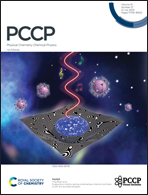Ab initio prediction of key parameters and magneto-structural correlation of tetracoordinated lanthanide single-ion magnets†
Abstract
Single-molecule magnets (SMMs) have great potential in becoming revolutionary materials for micro-electronic devices. As one type of SMM and holding the performance record, lanthanide single-ion magnets (Ln-SIMs) stand at the forefront of the family. Lowering the coordination number (CN) is an important strategy to improve the performance of Ln-SIMs. Here, we report a theoretical study on a typical group of low-CN Ln-SIMs, i.e., tetracoordinated structures. Our results are consistent with those of experiments and they identify the same three best Ln-SIMs via a concise criterion, i.e., the co-existence of long τQTM and high Ueff. Compared to the record-holding dysprosocenium systems, the best SIMs here possess τQTM values that are shorter by several orders of magnitude and Ueff values that are lower by ∼1000 Kelvin (K). These are important reasons for the fact that the tetracoordinated Ln-SIMs are clearly inferior to dysprosocenium. A simple but intuitive crystal-field analysis leads to several routes to improve the performance of a given Ln-SIM, including compression of the axial bond length, widening the axial bond angle, elongation of the equatorial bond length and usage of weaker equatorial donor ligands. Although these routes are not brand-new, the most efficient option and the degree of improvement resulting from it are not known in advance. Consequently, a theoretical magneto-structural study, covering various routes, is carried out for the best Ln-SIM here and the most efficient route is shown to be widening the axial ∠O–Dy–O angle. The most optimistic case, having a ∠O–Dy–O of 180°, could have a τQTM (up to 103 s) and Ueff (∼2400 K) close to those of the record-holders. Subsequently, a blocking temperature (TB) of 64 K is predicted to be possible for it. A more practical case, with ∠O–Dy–O being 160°, could have a τQTM of up to 400 s, Ueff of around 2200 K and the possibility of a TB of 57 K. Although having an inherent precision limit, these predictions provide a guide to performance improvement, starting from an existing system.



 Please wait while we load your content...
Please wait while we load your content...